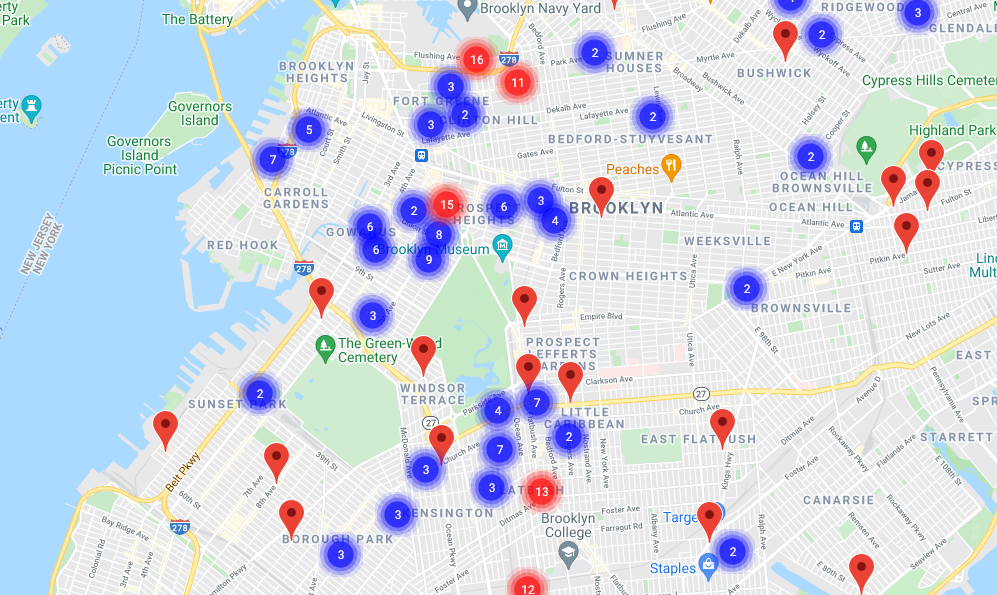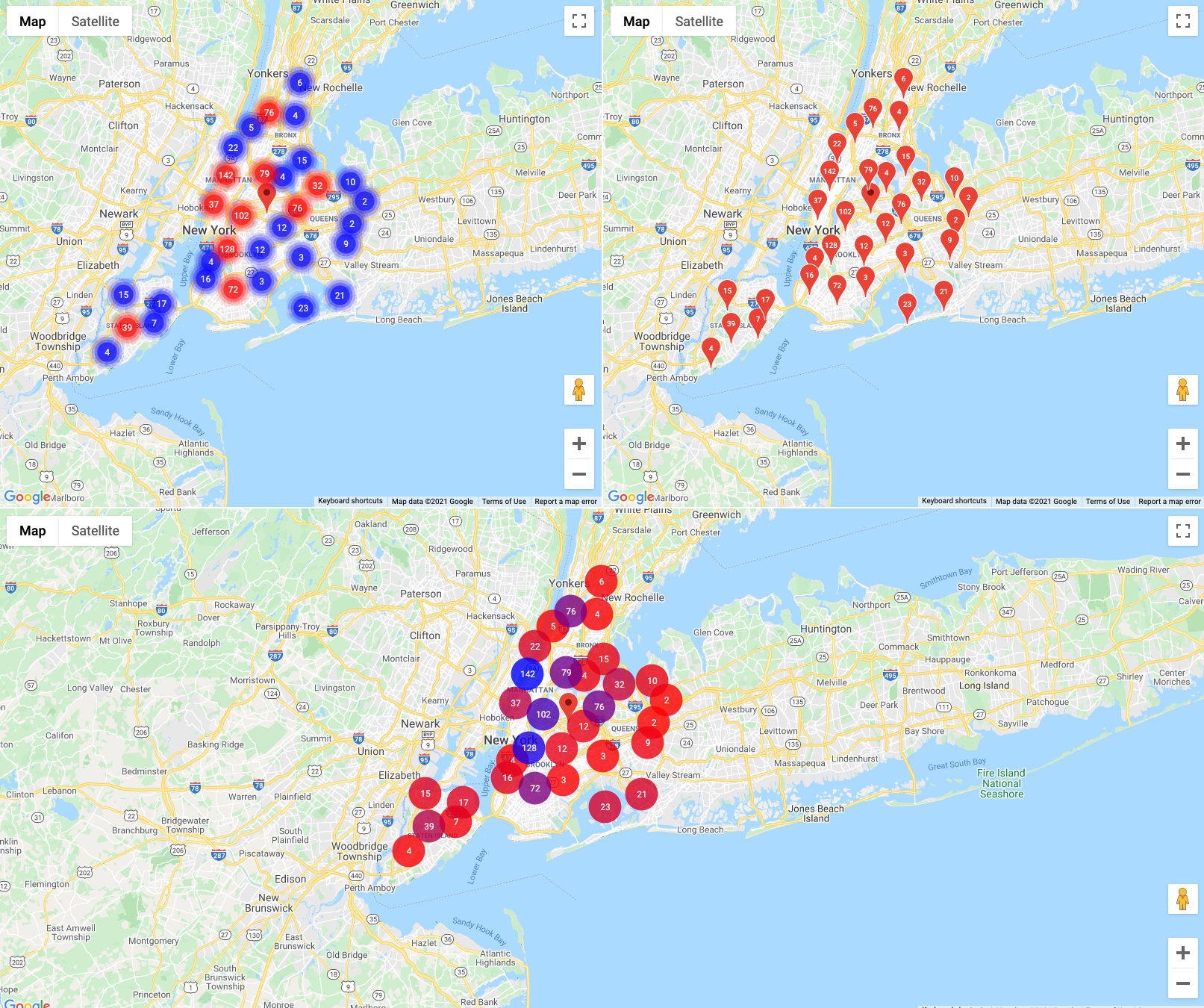@googlemaps/js-markerclusterer
Google Maps JavaScript MarkerClusterer
Description
The library creates and manages per-zoom-level clusters for large amounts of markers.

See the history section and migration section for how this library relates to @google/markerclusterer and @googlemaps/markerclustererplus.
Requirements
- Sign up with Google Maps Platform
- A Google Maps Platform project with the Maps Javascript API enabled
- An API key associated with the project above
- @googlemaps/markerclusterer NPM package
Installation
Install the @googlemaps/markerclusterer NPM package with:
npm i @googlemaps/markerclusterer
Alternativly you may add the umd package directly to the html document using the unpkg link.
<script src="https://unpkg.com/@googlemaps/markerclusterer/dist/index.min.js"></script>
When adding via unpkg, the MarkerClusterer can be accessed at markerClusterer.MarkerClusterer.
TypeScript
This library uses the official TypeScript typings for Google Maps Platform, @types/google.maps.
npm i -D @types/google.maps
Documentation
The documentation is generated from the TypeScript definitions.
Usage
Examples
import { MarkerClusterer } from "@googlemaps/markerclusterer";
// use default algorithm and renderer
const markerCluster = new MarkerClusterer({ map, markers });
To run the examples:
- Install dependencies:
npm install - Start the development server in the root folder:
npm run dev - Navigate to http://localhost:8080/ in your web browser.
- Provide a valid Google Maps Platform API key.
Examples details:
-
Algorithm Comparisons - This example demonstrates the different algorithms. Please note that spacing and many other options can be changed for each algorithm.
-
Renderer Usage - This example demonstrates different renderers similar to the image below.

History
This library has a heritage in @google/markerclusterer and @googlemaps/markerclustererplus, originally made available on code.google.com and then transferred to GitHub at https://github.com/googlemaps/v3-utility-library. The following is an approximate timeline.
- 201X - @google/markerclusterer was created.
- 201X - @googlemaps/markerclustererplus was created.
- 2019 - Libraries were published to NPM.
- 2019 - @google/markerclusterer was deprecated for @googlemaps/markerclustererplus.
- 2020 - @googlemaps/markerclustererplus was refactored to TypeScript.
- 2020 - @googlemaps/markerclustererplus was moved to a separate repository.
- 2021 - @googlemaps/markerclustererplus was rewritten as [@googlemaps/markerclusterer (new)][@googlemaps/markerclusterer].
- TBD - @googlemaps/markerclustererplus is deprecated for [@googlemaps/markerclusterer (new)][@googlemaps/markerclusterer].
Migration
The API of [@googlemaps/markerclusterer][@googlemaps/markerclusterer] has changed in a number of ways from @googlemaps/markerclustererplus.
- The
MarkerClustererclass now accepts analgorithmandrendererparameter to allow for more flexibility. The interface looks like the following:
{
algorithm?: Algorithm;
map?: google.maps.Map;
markers?: google.maps.Marker[];
renderer?: Renderer;
onClusterClick?: onClusterClickHandler;
}
- The
MarkerClustereraccepts a single options argument instead of positional parameters. - The traditional
GridAlgorithmis still supported, but is not the default. The default is supercluster which uses k-d trees for improved performance. - Styling of clusters has been simplifed and moved to the renderer interface.
- The
MarkerClustererclass is still an instance ofgoogle.maps.OverlayView, but usesgoogle.maps.Markers instead ofgoogle.maps.Overlayto render the clusters. This solves issues related to the usage of map panes and click handlers. - @googlemaps/markerclusterer supports Marker and Map a11y improvements.
Contributing
Contributions are welcome and encouraged! If you'd like to contribute, send us a pull request and refer to our code of conduct and contributing guide.
Terms of Service
This library uses Google Maps Platform services. Use of Google Maps Platform services through this library is subject to the Google Maps Platform Terms of Service.
This library is not a Google Maps Platform Core Service. Therefore, the Google Maps Platform Terms of Service (e.g. Technical Support Services, Service Level Agreements, and Deprecation Policy) do not apply to the code in this library.
European Economic Area (EEA) developers
If your billing address is in the European Economic Area, effective on 8 July 2025, the Google Maps Platform EEA Terms of Service will apply to your use of the Services. Functionality varies by region. Learn more.
Support
This library is offered via an open source license. It is not governed by the Google Maps Platform Support [Technical Support Services Guidelines, the SLA, or the Deprecation Policy. However, any Google Maps Platform services used by the library remain subject to the Google Maps Platform Terms of Service.
This library adheres to semantic versioning to indicate when backwards-incompatible changes are introduced. Accordingly, while the library is in version 0.x, backwards-incompatible changes may be introduced at any time.
If you find a bug, or have a feature request, please file an issue on GitHub. If you would like to get answers to technical questions from other Google Maps Platform developers, ask through one of our developer community channels. If you'd like to contribute, please check the contributing guide.
You can also discuss this library on our Discord server.







